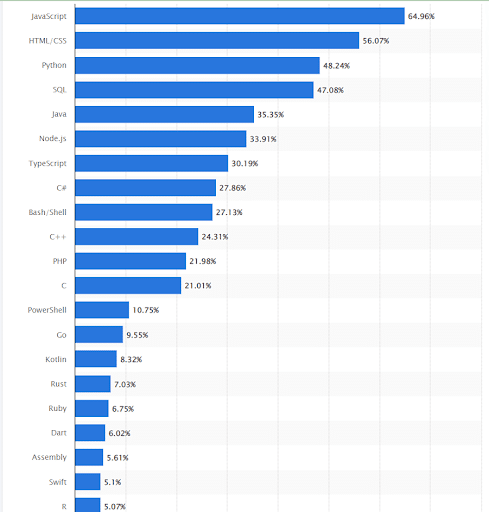Our digital topography is changing drastically, opening challenges to past developments and inviting innovations, advanced and dynamic. Technology today has bought everything within our grasp. It hints at the importance of an attractive user interface and dynamic web content which satisfies consumer demands. Hence, professionals often execute web automation using javascript. It’s one of the most versatile and popular programming languages experts prefer for end-to-end testing. It is considered one of the core languages of the World Wide Web besides CSS and HTML. JavaScript is a lightweight, object-oriented programming language with first-class functions that finds employment in around 97% of websites on the client-side for regulating web page behavior.

AUTOMATION USING JAVASCRIPT
JavaScript is one of the most common options for scripting. It is frequently used to construct online apps, as the MEAN stack is employed to develop a substantial percentage of web applications (MongoDB, Express.js, AngularJS, and Node.js). You can test automation using javascript and execute web automation using javascript. You can also perform end-to-end testing of frameworks and automated UI testing for applications by utilizing JavaScript to develop test scripts. Test automation using javascript increases the efficiency of repetitive tasks online and gives quick feedback.
LIST OF TOP 5 FRAMEWORKS
jQuery is a JavaScript library that is cross-platform and facilitates the use of JavaScript on web pages. Before being surpassed by React.js, jQuery was the most popular web framework among millions of software engineers worldwide. While jQuery is losing popularity as a whole, it is in use by veteran programmers for an end to end testing. JavaScript programmers earn a median annual pay of USD 54,050.

Below we have listed the top 5 frameworks to test automation using JavaScript.
-
WEBDRIVERIO
WebdriverIO is a test automation framework that allows both browser and native mobile testing, contrary to Selenium WebDriver, which only supports browser testing. It is extendable and can automate tests for apps running in any modern browser or mobile operating system. The framework’s ability to accommodate a wide range of testing requirements makes it an excellent option for developing and testing apps. It is pre-installed with Puppeteer and integrates with Jasmine, Mocha, and Cucumber. The entire setup takes only a few npm instructions.
To summarise, utilize WebdriverIO if you have comprehensive testing requirements beyond standard JavaScript tests.
-
CYPRESS
Cypress is a popular JavaScript testing framework, owing partly to its ease of use, especially if you are a front-end developer. The framework can handle both front-end and (to a lesser extent) backend testing. As a result, Cypress is an excellent alternative for developers that use JavaScript (or Node) for both server-side and client-side programming. Its limitations include restricted support for testing mobile apps: it can only handle mobile apps that run natively in a browser. Cypress also only currently supports three browsers: Chrome, Edge, and Firefox.
-
TESTCAFE
TestCafe is similar to Cypress in that it is simple to install. It facilitates end-to-end testing and also has the advantage of supporting both JavaScript and TypeScript as testing script languages. Developers favoring heavily typed languages find TypeScript appealing. The main desktop browsers, including Chrome, Internet Explorer, Edge, and Safari, are also supported by TestCafe. It offers limited support for browser-based mobile apps and only supports client-side programs. It is used as regression and end-to-end testing framework. TestCafe is not suitable for a unit or integration testing.
-
PLAYWRIGHT
Playwright, open-source test automation using a javascript framework released by Microsoft in January 2020, is one of the newest JavaScript-based test automation frameworks available. It offers testing in NET C#, Java, and Python, besides JavaScript, and is beneficial for developers that use several languages. It also supports all major current browsers, except Internet Explorer, and it can perform desktop and mobile testing. However, as the framework is still in its early stages, it does not provide as many connectors as more established frameworks. Support for Internet Explorer is absent, and Playwright requires a specific browser to perform tests. It adds time to testing processes and prevents you from testing on the browser that your users are using. Playwright requires manual integration with test frameworks such as Mocha, Jasmine, or Jest.
A playwright is an appealing option for developer-friendly, cross-browser testing that supports multiple languages, including but not limited to JavaScript. If you need to test for Internet Explorer, you will need to use a different framework. If you are concerned about quickly changing APIs, you may want to wait for Playwright to mature.
-
HEADSPIN
The primary goal is to simulate a real-world user situation while verifying the system and its components for integration and data integrity. Today’s software systems are complicated and integrated with several subsystems. If any of the subsystems fails, the entire software system may fail. To prevent this risk, Headspin employs end-to-end testing. A well-thought-out approach for end-to-end testing frameworks will include steps ranging from verification to testing. If one of the software subsystems is not well-tested, the entire system may collapse and fail. As a result, end-to-end testing is crucial for ensuring that each application works properly. Well-curated end-to-end testing frameworks guarantee that the tested application works as intended across devices with varying screen sizes, resolutions, operating systems, hardware, and carrier networks.
CONCLUSION
According to a survey, approximately 66% of respondents preferred JavaScript over other languages.
The primary goal of automated testing frameworks is to improve the efficiency of operations. They decouple test data from logic, promote test reuse, and accelerate test design and maintenance. To test multiple automated testing frameworks, it is critical to select the framework that is most suited to the application. Choosing the best fit and organized framework may increase the testing team’s productivity, improve test correctness, maximize test coverage, and decrease expenses and maintenance, resulting in a greater return on investment (ROI). The wage for JavaScript programmers in the United States is substantially higher than in other regions of the world, at 112,000 US dollars, demanding them understand the functionalities better.











































